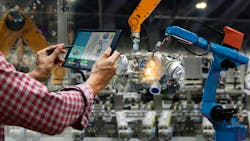Industrial robot adoption has reached a point of no return. Automated machinery has become an industry standard and will only become increasingly common as time goes on. As this trend continues, engineers must hone in on making this equipment safer to work around.
It’s all too easy to think of robot design as a way to optimize workflows apart from human employees. However, robot growth may face significant challenges if engineers don’t prioritize these human workers when designing new equipment.
Why Industrial Robot Design Must Emphasize Safety
Human factors must play a role in industrial robot design, if nothing else, then because robot-human interactions are rising. According to one survey, 44.9% of manufacturing companies not only use robots but say they’re integral to their operations. Of these, more than a third employ collaborative robots (cobots), which work closer to humans than conventional alternatives.
As demands for efficiency and precision rise and available options grow, robots will only become more common. Consequently, more human employees will find themselves in close contact with these machines. That proximity can make accidents like collisions more likely.
READ MORE: 10 Tips for Automation Success
In most cases, robots improve workplace safety. They often handle tasks like heavy lifting, so workers face less risk of musculoskeletal injuries. However, these machines present hazards of their own—risks that may become more prominent as cobot adoption grows.
Highly automated Amazon facilities show a worrying trend. More than half of all Amazon facilities experience double the average injury rate, and these higher rates were most common at warehouses using more robots.
Of course, correlation doesn’t imply causation. These parallels could be a byproduct of the fact that Amazon is more likely to automate facilities that are already more injury prone. However, it could also signify that rising automation has safety implications humans don’t fully understand. In either case, robotics design must err on the side of caution and prioritize human safety to ensure cobot adoption does more good than harm.
How Machine Learning Improves Robot Safety
One of the most promising strategies to improve safety in robot design is to integrate machine learning. This branch of artificial intelligence (AI) teaches algorithms to discover trends in data and apply these insights to new situations. That’s important for industrial safety because it allows robots to account for less familiar circumstances.
Machine vision is the most prominent use case for this technology in industrial safety. When cobots can identify their surroundings—including nearby human workers—they can adjust in real time to avoid collisions and similar accidents. This is the driving force behind autonomous vehicles and a potential game-changer for industrial robots.
Some machine vision models can detect and track objects 1,000 times faster than human vision with over 90% accuracy. Integrating these systems into cobots can help them recognize and avoid humans as they work the same way an employee would move to avoid bumping into a co-worker.
Machine learning has other safety-boosting applications, too. It can teach robots to recognize when some objects are misaligned so they can orient them properly before working on them. This, in turn, could reduce accidents from manufacturing errors. Machine learning algorithms could also monitor the robot itself to recognize maintenance issues and alert relevant technicians to prevent hazardous breakdowns.
Remaining Obstacles With AI
As promising as machine learning is, it’s not yet a perfect solution. While machine vision is more than fast and accurate enough for tasks like quality control, dealing with humans adds another layer of urgency. When a single mistake could mean injury, these systems shouldn’t just be good—they should be near perfect.
High crash rates among autonomous cars showcase the dangers of these imperfections. Over the past 10 years, there have been more than 700 autonomous car collisions in California alone. While that’s substantially lower than conventional cars, there are much fewer self-driving vehicles, and most haven’t taken the roads until recently.
READ MORE: Picking, Purchasing and Programming Your First Industrial Robot
While factory floors aren’t as complex as public roadways, this trend highlights a prominent issue with AI. Even though machine learning is more adaptable than conventional automation, it still struggles with unpredictable situations. Humans are inherently unpredictable in these contexts, so machine vision must go a long way before it can reliably navigate around workers.
Machine learning is also expensive and complex. That will change with time and research, but for now, it limits the feasibility of integrating it into robotic systems, especially at a price most manufacturers can afford.
Other Methods to Improve Industrial Robot Safety
As AI professionals work to improve machine learning models, robot designers can take other steps to boost their products’ safety. While no one solution is perfect, combining multiple can yield significant improvements.
Workflow Redesign
One of the most effective ways to improve robot safety apart from AI is to redesign robotic workflows. More specifically, workflows should minimize human-robot touchpoints to prevent unexpected hazards and collisions. Robots won’t have to recognize humans and other obstacles more accurately if they only encounter them in minimal, predictable scenarios.
This doesn’t mean manufacturers should avoid cobots altogether. Rather, they should rethink what human-robot collaboration looks like. Studies show simultaneous collaboration—where humans and robots work on different parts of the same task to reduce the need for coordination—increases efficiency and productivity compared to manual work or automation alone.
The simplest way to enable this is to ensure workflows follow a linear path where human and robot movement never intersects. Alternatively, manufacturers could ensure they only use mobile robots where humans aren’t present or stand still and have people move around where robots are stationary.
Physical Barriers
Another approach is to install physical barriers on or around robots to block hazardous collisions. This strategy is already common among industrial robots in the form of fencing, rails and other stationary shields. The advantage here is dangerous robot-human interactions become virtually impossible, but manufacturers must sacrifice flexibility to do so.
Effective implementation of this strategy—as in many other cases—is mainly an issue of knowing where to apply it. Motion-heavy workflows such as material handling aren’t ideal for this approach, as barriers will limit movement. However, stationary tasks like quality inspections or machining work well with physical stops.
Worker Training
Looking past the robots themselves to focus on their human coworkers can also help. Many workplace accidents stem from human error, and cobot-heavy workflows are no different. Hazardous interactions are more likely when workers don’t understand how to work with robots appropriately and safely, and thorough training is the solution.
READ MORE: Day 1 at Automate 2024: Announcements, Embargoes Lifted, Rollouts and More
Making robots easier to work with starts with designers, who must consider user-friendliness when creating cobots. Then, it falls to manufacturers to train their employees on how their robots work and what sort of actions to avoid to prevent dangerous run-ins.
This step will become increasingly crucial as robot adoption grows as an answer to worker shortages. For example, robotic welding systems are becoming more common because the industry is short 290,000 welders today. While automation is a helpful solution, workers may be more likely to make mistakes because the shortage leaves them with higher workloads. Emphasizing robot safety in training becomes essential as a result.
Industrial Robots and Mental Health
As robotics engineers and manufacturers consider these safety factors, they must be careful not to overlook employees’ mental health. Most conversations around industrial robots and their impact on workplace safety focus on the physical. However, mental health problems can be just as damaging to employees and make physical health incidents more likely in some cases.
Rising automation often increases job insecurity fears, and can cause stress and anxiety in workers. These negative feelings make it difficult to focus, which could make workplace injuries from human error more likely. Even if things don’t reach that point, the drop in morale will limit workplace productivity and could drive unhealthy behaviors in workers’ personal lives.
These issues are complex and difficult to tackle, especially from the lens of robotics design. That said, improvement is possible. Both the companies making industrial robots and those using them can assuage potential mental health effects through a few proactive measures.
First, robotics engineers should focus on designing products to work alongside humans instead of replacing them. This is often a matter of leaning into automation’s strengths while leaving human’s unique abilities—namely, adaptability and creativity—to end users instead of trying to automate it. For example, a robot could weld pieces together but require a human to ensure proper alignment and check the weld before and after the joining process.
On the implementation side, manufacturers must prepare their workforce for an automated future. While automation typically creates new jobs, it still displaces some workers because the positions it creates require different skills than those it takes or devalues. The solution is to upskill employees ahead of time. That means training them to work more efficiently with cobots and teaching them new, tech-oriented skills so they can take new positions as automation rises.
Industrial Robot Design Must Prioritize Human Health
It’s difficult to predict the full scope of robots’ impact on worker health, considering how quickly adoption rates are rising. Automation’s growth has not been gradual, so the industry hasn’t had time to adapt workflows fully. Given the potential safety risks—both physical and mental—of that transition, human health must become a priority for robot designers and users.
Careful design and implementation can make the robotic revolution a net positive for workplace safety. The industry must act now to secure that future.
Emily Newton has eight years of creating manufacturing articles under her belt. She loves helping people stay informed. Her work in Machine Design, American Machinist and Design and Development Today, showcases her ability to identify newsworthy stories. When Emily isn't writing, she enjoys building Lego sets with her husband.
About the Author

Emily Newton
Emily Newton is a technology and industrial journalist. She is also the editor in chief of Revolutionized. She has over five years covering stories about warehousing, logistics and distribution.
